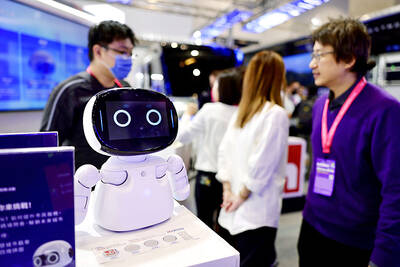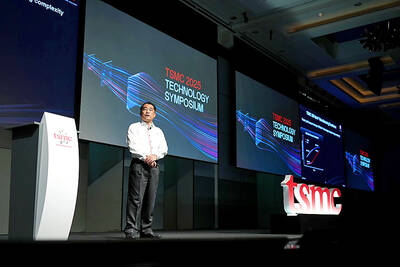Hewlett-Packard Co (HP) announced a US$1.2 billion deal to buy Palm Inc, betting it can resuscitate the struggling smartphone maker to compete with the likes of Apple Inc and Research in Motion (RIM).
Analysts say this year’s third-largest US tech acquisition grants Palm’s devices global production and distribution reach, while launching the world’s top PC maker into a tech arena experiencing blistering growth.
The news on Wednesday surprised many on Wall Street, since much of the long-running takeover speculation surrounding Palm had shifted in recent weeks to focus on potential Asian bidders, such as China’s Lenovo (聯想).
An early pioneer in handheld devices, Palm once dominated the market but has since been surpassed by Apple’s iPhone and RIM’s BlackBerry.
Palm put out a new mobile operating system, the well-reviewed webOS, last year, but even that has been overshadowed by Google Inc’s Android software.
In a sign of Palm’s struggles, the money-losing company headed by Jon Rubinstein — a former Apple executive famous for developing the iPod — slashed revenue expectations for the current quarter. It said slow product sales have led to low order volumes from carriers.
Palm reported losses for each of its last two fiscal years.
Shares of Palm, 30 percent owned by Elevation Partners, jumped 27 percent to US$5.88, above HP’s US$5.70 cash offer.
HP said the deal for Palm, which both boards have approved, valued the company at US$1.2 billion including debt. Based on Palm’s latest filing, the deal values Palm’s 167.892 million shares outstanding at US$957 million.
Analysts said HP has deep pockets to invest in Palm, can expand its carrier relationships and negotiate better component pricing from existing suppliers.
HP’s foray into the fiercely contested smartphone arena may not immediately threaten Apple and RIM’s BlackBerry but may increase pressure on Nokia, Motorola and other device manufacturers now battling to expand their market share.
“Nokia will be one of the most affected players,” IDC analyst Francisco Jeronimo said. Because of a “wrong portfolio and lack of carrier support, Nokia never moved from its eighth position ... in the smartphone segment. This deal puts also pressure on Motorola and HTC (宏達電).”
Others, however, were more skeptical about HP’s ability to turn around Palm, whose Pre and Pixi phones have withered in the face of fierce competition.
“If HP wants to have a global role in the mobile space, spending US$1.2 billion in Palm is not the way. Palm has no brand outside the US, and it has no distribution outside the US,” said John Strand, chief executive of Strand Consult.
“To pay US$1.2 billion for a US-centric mobile player that’s not successful is a first-class way to destroy shareholder value. Palm has tried to move from the PDA world into the mobile world for eight years without success,” Strand said.
According to Gartner, Palm held 1.2 percent of the global smartphone market last year, compared with Nokia’s 41.1 percent, RIM’s 19.9 percent and Apple’s 14.4 percent.
Palm now expects fiscal fourth quarter revenue in the range of US$90 million to US$100 million, compared with its forecast last month that revenue would be less than US$150 million.
Todd Bradley, executive vice president of HP’s computer division, said the company plans to “invest heavily” in Palm, increasing spending on sales and marketing and research and development in the hope of spurring the developer community into writing more applications for the platform.
HP already has a smartphone, the iPaq, which runs on Microsoft’s Windows mobile platform, but the device has gained little traction in a crowded market.
Rubinstein is expected to remain with the company, HP said in a statement, adding that the acquisition would likely close during its third fiscal quarter ending July 31.
Shares of HP fell 1 percent to US$52.75 in extended trading from their New York Stock Exchange close of US$53.28.

DEMOGRAPHICS: Robotics is the most promising answer to looming labor woes, the long-term care system and national contingency response, an official said Taiwan is to launch a five-year plan to boost the robotics industry in a bid to address labor shortages stemming from a declining and aging population, the Executive Yuan said yesterday. The government approved the initiative, dubbed the Smart Robotics Industry Promotion Plan, via executive order, senior officials told a post-Cabinet meeting news conference in Taipei. Taiwan’s population decline would strain the economy and the nation’s ability to care for vulnerable and elderly people, said Peter Hong (洪樂文), who heads the National Science and Technology Council’s (NSTC) Department of Engineering and Technologies. Projections show that the proportion of Taiwanese 65 or older would

Nvidia Corp yesterday unveiled its new high-speed interconnect technology, NVLink Fusion, with Taiwanese application-specific IC (ASIC) designers Alchip Technologies Ltd (世芯) and MediaTek Inc (聯發科) among the first to adopt the technology to help build semi-custom artificial intelligence (AI) infrastructure for hyperscalers. Nvidia has opened its technology to outside users, as hyperscalers and cloud service providers are building their own cost-effective AI chips, or accelerators, used in AI servers by leveraging ASIC firms’ designing capabilities to reduce their dependence on Nvidia. Previously, NVLink technology was only available for Nvidia’s own AI platform. “NVLink Fusion opens Nvidia’s AI platform and rich ecosystem for

Taiwan Semiconductor Manufacturing Co (TSMC, 台積電) yesterday said it is building nine new advanced wafer manufacturing and packaging factories this year, accelerating its expansion amid strong demand for high-performance computing (HPC) and artificial intelligence (AI) applications. The chipmaker built on average five factories per year from 2021 to last year and three from 2017 to 2020, TSMC vice president of advanced technology and mask engineering T.S. Chang (張宗生) said at the company’s annual technology symposium in Hsinchu City. “We are quickening our pace even faster in 2025. We plan to build nine new factories, including eight wafer fabrication plants and one advanced

‘WORLD’S LOSS’: Taiwan’s exclusion robs the world of the benefits it could get from one of the foremost practitioners of disease prevention and public health, Minister Chiu said Taiwan should be allowed to join the World Health Assembly (WHA) as an irreplaceable contributor to global health and disease prevention efforts, Minister of Foreign Affairs Lin Chia-lung (林佳龍) said yesterday. He made the comment at a news conference in Taipei, hours before a Taiwanese delegation was to depart for Geneva, Switzerland, seeking to meet with foreign representatives for a bilateral meeting on the sidelines of the WHA, the WHO’s annual decisionmaking meeting, which would be held from Monday next week to May 27. As of yesterday, Taiwan had yet to receive an invitation. Taiwan has much to offer to the international community’s